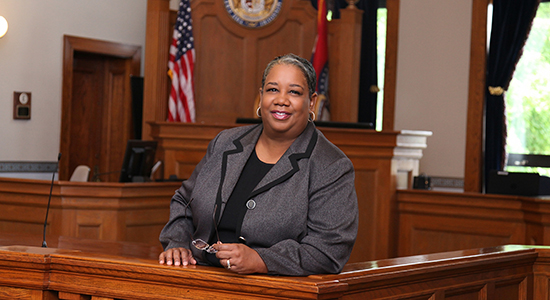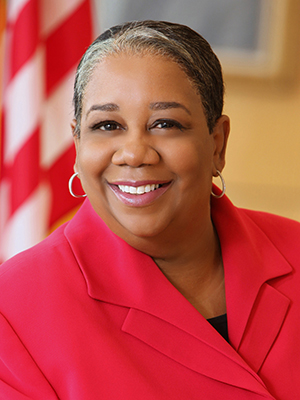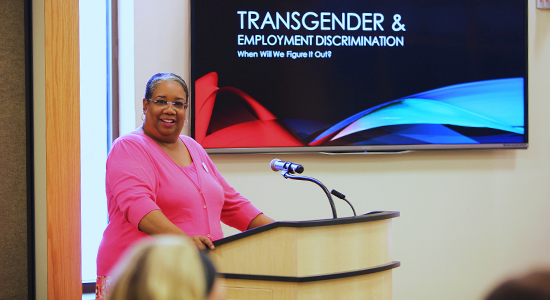
“The first thing to understand is that everybody has implicit bias,” says Dana Tippin Cutler, the first woman of color to serve as the president of The Missouri Bar (2016-17), and a guest speaker at the State Bar of Wisconsin’s upcoming Annual Meeting and Conference.
May 16, 2018 – Four years ago, the American Lawyer and other commentators spotlighted the legal profession’s “diversity crisis,” noting a profession that fights for justice and equality but “has failed to set an example in its own workplaces.”1
Four years later, what commentators saw as a “diversity crisis” in 2014 is really no different today, at least when looking at major law firm statistics. In fact, data from the last decade reveals little change on progress for women and minorities in law firms.
About 45 percent of associates in major U.S. law firms are women, on average, but only 22 percent of law firm partners are women. About 23 percent of lawyers in law firms are minorities, on average, but only 8 percent of law firm partners are minorities, according to the 2017 Diversity Report from the National Association for Law Placement (NALP).
An Obstacle to Diversity: Implicit Bias
Accepting that the legal profession is diversity-challenged and diversity is important, a logical next question is: What are the obstacles to a diverse legal profession?
Diversity is a multi-layered challenge. But one obstacle is implicit bias, says Dana Tippin Cutler, the first woman of color to serve as the president of The Missouri Bar (2016-17).
“The first thing to understand is that everybody has implicit bias,” said Cutler, a guest speaker at the State Bar of Wisconsin’s upcoming 2018 Annual Meeting and Conference (AMC), June 21-22, at the Grand Geneva Resort in Lake Geneva.
“Implicit bias can be harmful, neutral, or protective. But we all bring unconscious, implicit bias to the table. The key is to talk about it in a safe environment,” said Cutler, who has developed a mechanism to do just that. It’s called Courageous Collaboration.

Implicit Bias in Law Firms
In 2015, Valparaiso Law School Professor Nicole Negowetti (now a law professor at Harvard Law School) dug deep into the harmful impacts of implicit bias in the legal profession, particularly under the traditional structure of law firms.2
Negowetti’s research highlighted how implicit bias can impact decision-making at all phases of the law firm cycle: hiring, training, mentoring, evaluating, and promoting.
For instance, firms that employ informal assignment processes allow partners to select associates to complete assignments, forcing associates to jockey for position. But this model may place women and minorities at a distinct disadvantage from day one.
 Joe Forward, Saint Louis Univ. School of Law 2010, is a legal writer for the State Bar of Wisconsin, Madison. He can be reached by email or by phone at (608) 250-6161.
Joe Forward, Saint Louis Univ. School of Law 2010, is a legal writer for the State Bar of Wisconsin, Madison. He can be reached by email or by phone at (608) 250-6161.
“A socially constructed assignment process is influenced by implicit bias because partners, who are predominantly white males, distribute assignments to those with whom they naturally felt an affinity – associates who were most like themselves.”3
The research suggests that women and minorities don’t rise to partnership level as often because they don’t have the same opportunities, and may leave because of it.
Associates of color, in one study, identified lack of opportunity to work on important matters and “lack of relationships” as reasons for ultimately leaving the firm.4
Another study found that “fewer women were assigned high-profile, high-revenue assignments because male partners made certain negative assumptions about the type of work they wanted,” or women were frequently assigned pro bono matters.5
Implicit bias seeps into law firm decision-making elsewhere, including the hiring stage, or during evaluation. “Research has demonstrated that implicit bias can compel people to favor those who are most similar to themselves, thereby leading to a tendency for managers to hire those whose qualities align with their own,” Negowetti notes.6
“Studies also show that attorneys who assume that attorneys of color have achieved success due to preferential treatment, and not solely because of merit, will more readily recall their errors rather than their contributions to the firm.”7
Negowetti’s article explores the social cognition research regarding implicit bias to make sense of the legal profession’s “diversity crisis,” and how the cycle perpetuates itself. But here’s the good news: Implicit bias can be deactivated, once we know it’s there.
“Three decades of research demonstrates that once activated, implicit biases influence many of our behaviors and judgments in ways we cannot access and often cannot control,” Negowetti wrote. “Fortunately, studies show that these biases are not permanent, and that we can deactivate the stereotypes we hold.”8
Other Industries Tackling Diversity
In 1970s and 1980s, orchestras began using blind auditions, which allowed women to overcome the unconscious bias that favored men as classical musicians.
Several entrepreneurs have borrowed this model in recent years, creating software that allows applicants to “blind audition” for a job. The software eliminates the ability to infer ethnicity, gender, age, or educational background in the application review process.
“Our platform is a lot like the reality TV competition show, 'The Voice,’” software developer Peter Vujosevic told Business Insider. “The judges have their backs turned away from the talent, and they decide whether to proceed to the next round based on the contestant's vocal skills – not their looks, not their race, not their gender.”
Companies like Google started “bias busting” workshops to increase diversity in the technology industry by breaking down barriers for discussion. “Rather than thinking about this as a problem about a handful of bad apples or racist people, it creates a space where we can all talk about the different biases we have. This is a people problem. We all have this issue,” diversity consultant Jonathan Brack told USA Today.
Let’s Air it Out
Remember, implicit bias is unconscious. It is not overt or purposefully discriminatory, Cutler says. Discussions about implicit bias should not be accusatory or place blame.
“The typical conversation about diversity is what white attorneys are not doing for attorneys of color,” said Cutler, who is African-American. “And I say, yes, that might be true. But there’s another side to this coin, and we need to talk about it.”
Cutler says once people understand and accept their own implicit bias, they can begin to engage in productive and meaningful discussions on topics like diversity and inclusion, generational differences, office culture, or professional expectations.
For instance, how do traditional law firm partners who are protecting the bottom line square with young lawyers who seek the flexibility and autonomy the partners never had? How do bar associations grapple with issues of diversity when diverse members are hesitant to participate? How do we create the space to bring implicit bias to light?
Courageous Collaboration, says Cutler, is a communication model that can help. It’s helping law firms, lawyers, and bar associations come together, communicate differing perspectives and interests, and negotiate practical resolutions on important issues.
For Cutler, the Courageous Collaboration initiative began during a diversity symposium, the year before her term as president of the Missouri Bar. Washington University Law School Professor Kim Norwood, who has done extensive study on implicit cognition, including the influence of media messaging, noted the global nature of implicit bias.
“It isn’t just a white-black thing,” Cutler said. “We all come to the table with our own life experiences and family histories, and the media can shape how we interact with each other. That caught my ear and I thought, ‘this is a good way to frame that conversation.’”
Cutler developed the framework, starting with identifying a facilitator and participants. The first task: Take Harvard’s Implicit Association Tests, which test implicit biases ranging from race and gender, to sexuality, religion, skin-tone, age, and weight.
The group discusses the tests and how the results may impact communications. Then the group puts it out there, “sharing what would not normally be shared for fear of retaliation, condemnation, or even lawsuits.” In this way, the group can build solutions.
“When I talked to my colleagues in larger firms trying to promote and support diversity or work-life balance,” Cutler said, “it was difficult because senior partners would say, we didn’t do that as younger lawyers. We didn’t make those kinds of concessions.”
And the partners should feel free to air that viewpoint, Cutler says. “Put it out there on the table so we can talk about it, because here’s the thing,” Cutler said. “He or she is going to be the person who has the power in the firm to effectuate change.”

Change Can Happen
Cutler notes one firm where younger attorneys were saying, ‘we have infants or families or want to volunteer. We don’t want to be here 70 hours per week.’”
And the partner is saying, “‘you have to bill this much for this law firm to survive. We can’t pay you these salaries if you are working part time.’”
“They had a real perspective: the bottom line,” Cutler said. “But then the younger attorneys come back and say, ‘look, we don’t mind working 70 hours, but why do we always have to be in the office to do it?’
Cutler notes the perception that older generations may bring to the table. “My dad is 75. He doesn’t believe you’ve been at work unless you are actually at work,” Cutler said.
If that’s out there, the sides can begin to discuss why flexibility matters for young lawyers, and how technology allows them to be at work, when they are not at work.
“From there, they came up with solutions, working from home, different work schedules, even on-site nannies for new mothers who agreed to share the cost with the firm,” Cutler said. “When you can unravel the barriers to communication, solutions happen.”
As a bar leader, Cutler understands the challenges that bar associations face in cultivating diversity among the membership and leadership.
“Diversity is a critical issue for bar associations,” Cutler said. “They want diversity, they want more voices. And I know what it feels like to go to diverse lawyers and say come join us, work with us. And they say, ‘I don’t want to. I have to deal with this all day at work, why would I want to go to an activity on Saturday and deal with the same issue?’”
“Minorities often reject those offerings because they don’t want to be around a bunch of white people talking about diversity,” Cutler said. “And I say, how can they become diverse if you won’t show up? We need better collaboration to open those doors.”
As a featured speaker at AMC, Cutler will help lawyers learn how to unravel the barriers through the Courageous Collaborations model that can help the legal profession address implicit bias and issues of diversity and inclusion in the legal profession.
“Once they get there and start to talk, they realize there is a happy middle ground between the moon and zero,” said Cutler, based in Kansas City. “And they end up fashioning or developing interesting resolutions to the issues.”
Courageous Collaboration with Dana Tippin Cutler at the 2018 Annual Meeting and Conference, June 21
Dana Tippin Cutler, former president of The Missouri State Bar, is on a panel that will engage in “A Conversation about Courageous Collaboration and Implicit Bias” on Thursday, June 21, at 11:10 a.m., at the State Bar of Wisconsin’s 2018 Annual Meeting and Conference at the Grand Geneva Resort in Lake Geneva. The program is sponsored by the State Bar of Wisconsin’s Diversity & Inclusion Oversight Committee.
Other featured speakers include Chief Judge Diane Wood of the Seventh Circuit Court of Appeals, Richard Painter, former chief ethics advisor to President George W. Bush, attorney and author William Domnarski, author and political satirist P.J. O’Rourke.
Check out the schedule at-a-glance, which includes a listing of social activities that will take place as attendees earn up to 12 CLE credits. Or just register now!
First-time attendee? Register by May 21 to receive $100 off the full registration price of $359. Returning attendees get $30 off the regular registration rate if registered before May 21, and discounted lodging rates apply with the May 21 early-bird registration.
Endnotes
1 Deborah L. Rhode, From Platitudes to Priorities: Diversity and Gender Equity in Law Firms, 24 Geo. J. Legal Ethics, 1041, 1041 (2011).
2 Nicole E. Negowetti, Implicit Bias and the Legal Profession's "Diversity Crisis": A Call for Self-Reflection, 15 Nev. L.J. 930 (2015).
3 Id. at 946.
4 Id. (citing Veronica Root, Retaining Color, 47 U. Mich. J.LL. Reform 575, 595-96 (2014)).
5 Id. (citing Luis J. Diaz & Patrick C. Dunican Jr. Ending the Revolving Door Syndrome in Law, 41 Seton Hall L. Rev. 947, 976 & 977 (2011)).
6 Id. at 944 (citing Marc Bendick, Jr. & Ana P. Nunes, Developing the Research Basis for Controlling Bias in Hiring, 68 J. Soc. Issues 238, 244 (2012)).
7 Id. at 948 (citing Rhode, supra note 1, at 1052).
8 Id. at 933-34.
